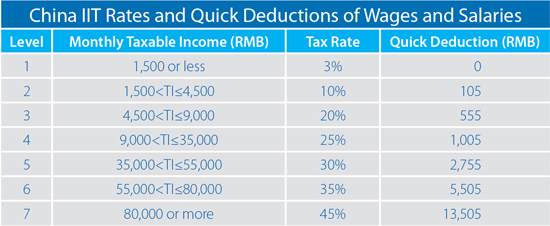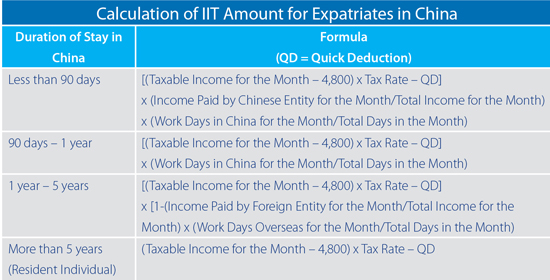How to Calculate Your 2013 Expatriate Individual Income Tax in China
The most recent information on Individual Income Tax is available here.
SHANGHAI – In China, an individual’s income from wages and salaries is taxed according to a progressive rate, depending on his/her duration of stay in China. Non-employment income is taxed at a variable rate depending on income type. In this article, we outline the rates and calculation methods for both income sources and overview the declaration process for individual income taxes in China.
Employment Income
Income from wages and salaries is taxed according to a progressive rate, which is categorized into seven levels ranging from 3 to 45 percent of monthly taxable income, as shown in the table below.

Specifically, wages and salaries include any kind of bonuses, allowances, and/or other income received from the employment of the individual. Certain employment benefits for foreign individuals may be treated as non-taxable under IIT law if relevant requirements are fulfilled. These include (with supporting invoices where applicable):
- Employee housing costs;
- Home leave fare of two trips per year for the employee, within reason;
- Relocation and moving costs, within reason;
- Reimbursement of certain meals, laundry, language training costs, and children’s education expenses in China, within reason.
In this sense, reimbursement may be a better approach for reducing IIT, because any cash allowance paid directly to cover expected work-related expenditures (such as an entertainment or travel allowance) will be fully taxable to an employee.
Monthly taxable income is calculated after a standard deduction of RMB3,500 for local employees. For foreign individuals working in China (including residents of Hong Kong, Taiwan, and Macau), the standard monthly deduction is RMB 4,800. Money paid into Chinese social insurance can also be added to the pretax deduction.
The basic formulae are as follows:
- Monthly Taxable Income for Foreign Individuals = Monthly Income – RMB 4,800
- Tax Payable = Taxable Income x Applicable Tax Rate – Quick Calculation Deduction
When calculating their IIT amount, foreign expatriates need to proportion their total taxable income based on income source and duration of stay in and outside of China during the month (the specific formulae are listed in the accompanying table). When counting the number of work days in China for IIT calculation purposes, the day on which an individual enters or exits China is counted as a half-day.

Non-Employment Income
Apart from wages and salaries, other non-employment income subject to IIT includes:
- Income from sole proprietors and merchants’ production and business operations;
- Income from contracting or leasing provided to enterprises and institutions;
- Remuneration for labor services;
- Author’s remuneration;
- Income from royalties;
- Income from interests, stock dividends, and bonuses;
- Income from the lease or transfer of property;
- Contingent and other forms of income.
Non-employment income is taxed at a rate generally ranging from 5 to 35 percent, depending on the income source.
IIT Filing and Declaration
China’s individual income tax (IIT) is normally withheld from wages or salaries by employers and paid to the tax authorities on a monthly basis (within 15 days of the end of each month). Individuals receiving overseas income should file an IIT return on the overseas income with the relevant tax authority within 30 days from the end of the tax year.
In addition, an annual IIT declaration should be submitted to the relevant tax authorities within three months of the end of the previous calendar year (i.e., between January 1, 2014 and March 31, 2014 for the 2013 calendar year) for taxpayers who are subject to IIT in China and meet at least one of the following five conditions:
- Have an annual income of more than RMB 120,000;
- Derive income from two or more places inside the PRC;
- Derive income from sources outside the PRC (note: this applies only to a resident or non-resident individual in China who has resided in China for more than 1 year);
- Received taxable income for which there is no withholding agent;
- Other conditions required by the State Council.
It is particularly emphasized that individuals with an annual income of more than RMB 120,000 are required to submit their IIT declarations, regardless of whether all the IIT liabilities have been fulfilled. In this context, annual income includes both employment income and non-employment income. However, a non-resident individual residing in China for less than one year during the tax year is exempt from such requirement.
An in-depth discussion on duration of stay and IIT liability for foreign employees in China is covered here.
Dezan Shira & Associates is a specialist foreign direct investment practice, providing corporate establishment, business advisory, tax advisory and compliance, accounting, payroll, due diligence and financial review services to multinationals investing in emerging Asia. Since its establishment in 1992, the firm has grown into one of Asia’s most versatile full-service consultancies with operational offices across China, Hong Kong, India, Singapore and Vietnam in addition to alliances in Indonesia, Malaysia, Philippines and Thailand as well as liaison offices in Italy and the United States.
For further details or to contact the firm, please email china@dezshira.com, visit www.dezshira.com, or download our brochure.
You can stay up to date with the latest business and investment trends across Asia by subscribing to Asia Briefing’s complimentary update service featuring news, commentary, guides, and multimedia resources.
Related Reading
 Payroll Processing Across Asia
Payroll Processing Across Asia
In this edition of Asia Briefing Magazine, we provide a country-by-country introduction to how payroll and social insurance systems work in China, Hong Kong, Vietnam, India and Singapore. We also compare three distinct models companies use to manage their payroll across various countries with external vendors, and explain the differences among three main models: country-by-country, managed, and integrated models while highlighting some benefits and drawbacks of each.
 The 2014 Asia Tax Comparator
The 2014 Asia Tax Comparator
In this issue of Asia Briefing Magazine, we examine the different tax rates in 13 Asian jurisdictions – the 10 countries of ASEAN, plus China, India and Hong Kong. We examine the on-the-ground tax rates that each of these countries levy, including corporate income tax, individual income tax, indirect tax and withholding tax. We also examine residency triggers, as well as available tax incentives for the foreign investor and important compliance issues.
 The China Tax Guide: Tax, Accounting and Audit (Sixth Edition)
The China Tax Guide: Tax, Accounting and Audit (Sixth Edition)
This edition of the China Tax Guide, updated for 2013, offers a comprehensive overview of the major taxes foreign investors are likely to encounter when establishing or operating a business in China, as well as other tax-relevant obligations. This concise, detailed, yet pragmatic guide is ideal for CFOs, compliance officers and heads of accounting who need to be able to navigate the complex tax and accounting landscape in China in order to effectively manage and strategically plan their China operations.
China Expat Tax Filing and Declarations for 2013 Income
Employers’ Overseas Social Insurance Contributions are IIT Taxable
China to Cancel Preferential IIT Policy for Foreigners
- Previous Article China Expat Tax Filing and Declarations for 2013 Income
- Next Article China Clarifies Tax Refund Policy on Goods Exported by Foreign Trade Service Providers

























